Matplotlib ievads
(1) Valoda un vide
(2) Datu punkti
(3) Joslas, histogrammas
(4) Anotēšana, eksplikācijas
(5) Aplīšu izmērs, krāsa
(6) 3D diagrammas
(7) MP4 video
- Matplotlib - populārs, bet ne vienīgais
- Bokeh
- Datashader (īpaši liels datu apjoms; vizualizācijas)
- Holoviews (anotācijas datiem, to vieglākai vizualizācijai)
- Seaborn
- Plotnine (diagrammu gramatika - līdzīgi ggplot2)
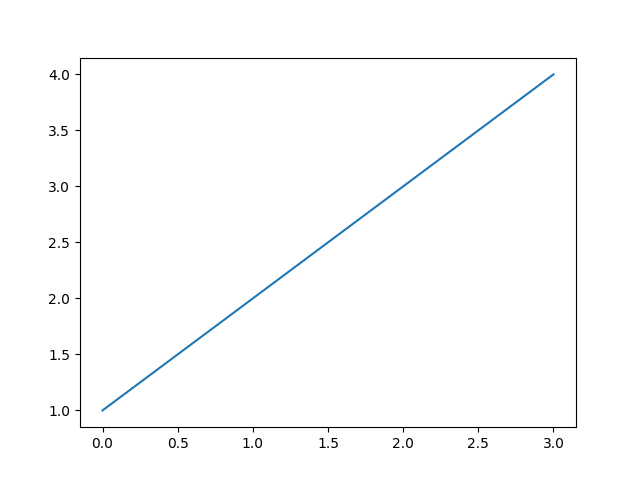
import sys
import matplotlib as mpl
print(sys.version)
print('mpl_graphs.__version__ = %s' % mpl.__version__)
print('mpl_graphs.__file__ = %s' % mpl.__file__)3.6.7 (default, Oct 22 2018, 11:32:17)
[GCC 8.2.0]
mpl_graphs.__version__ = 3.1.1
mpl_graphs.__file__ = ... ... /matplotlib/__init__.pyMatplotlib ievads
(1) Valoda un vide
(2) Datu punkti
(3) Joslas, histogrammas
(4) Anotēšana, eksplikācijas
(5) Aplīšu izmērs, krāsa
(6) 3D diagrammas
(7) MP4 video
import numpy as np
import matplotlib.pyplot as plt
a, b, N = 0., 1., 25
t = np.arange(a, b, (b-a)/N)
# sarkana svītrlīnija 'r--'
# zili kvadrātiņi 'bs'
# zaļi trijstūrīši 'g^'
plt.plot(t, t, 'r--',
t, t**2, 'bs',
t, t**3, 'g^')
plt.savefig('scatter_plain.png')
plt.show()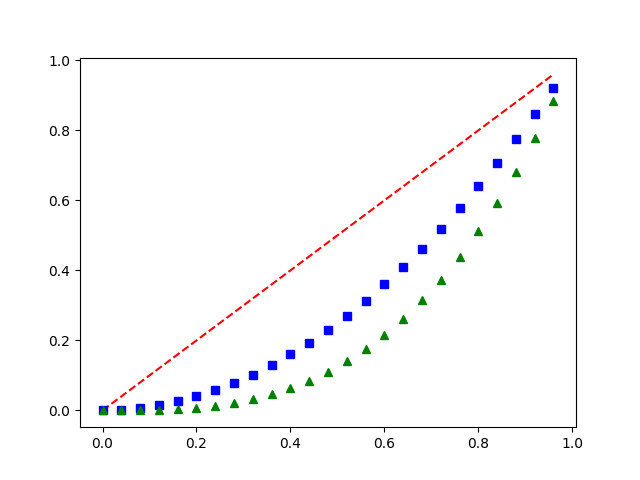
import numpy as np
import matplotlib.pyplot as plt
N = 60
g1 = (0.6 + 0.6 * np.random.rand(N),
np.random.rand(N))
g2 = (0.4+0.3 * np.random.rand(N),
0.5*np.random.rand(N))
g3 = (0.3*np.random.rand(N),
0.3*np.random.rand(N))
data = (g1, g2, g3)
colors = ("red", "green", "blue")
groups = ("coffee", "tea", "water")
fig = plt.figure()
ax = fig.add_subplot(1, 1, 1)
for data, color, group in zip(data, colors, groups):
x, y = data
ax.scatter(x, y, alpha=0.8, c=color,
edgecolors='none', s=30, label=group)
plt.title('Matplot scatter plot')
plt.legend(loc=2)
plt.savefig('scatter_multicolor.png')
plt.show()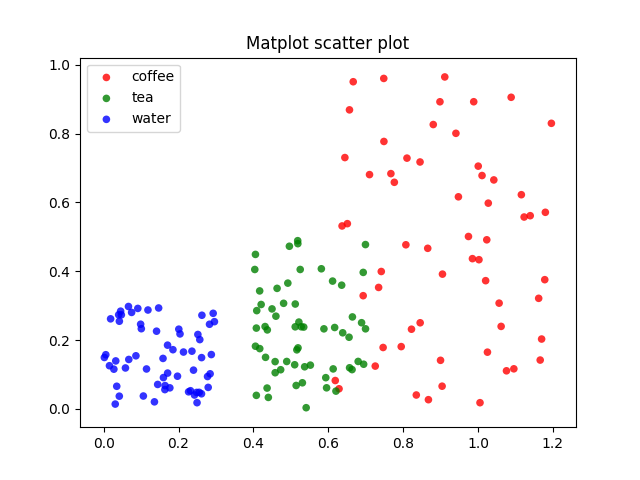
import numpy as np
import matplotlib.pyplot as plt
def f(t):
return np.exp(-t) * np.cos(2*np.pi*t)
t1 = np.arange(0.0, 5.0, 0.1)
t2 = np.arange(0.0, 5.0, 0.02)
plt.figure(1)
plt.subplot(211)
plt.plot(t1, f(t1), 'bo', t2, f(t2), 'k')
plt.subplot(212)
plt.plot(t2, np.cos(2*np.pi*t2), 'r--')
plt.savefig('scatter_function_graphs.png')
plt.show()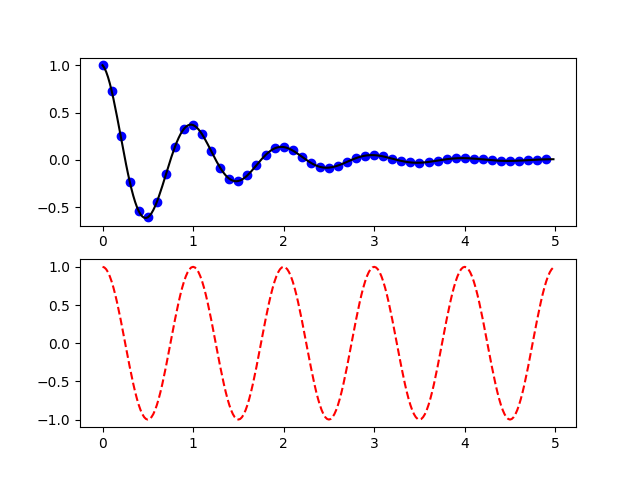
import matplotlib.pyplot as plt
plt.style.use('seaborn-whitegrid')
import numpy as np
x = np.linspace(0, 10, 50)
dy = 0.8
y = np.sin(x) + dy * np.random.randn(50)
plt.errorbar(x, y, yerr=dy, fmt='.k')
plt.savefig('scatter_dots_errors.png')
plt.show()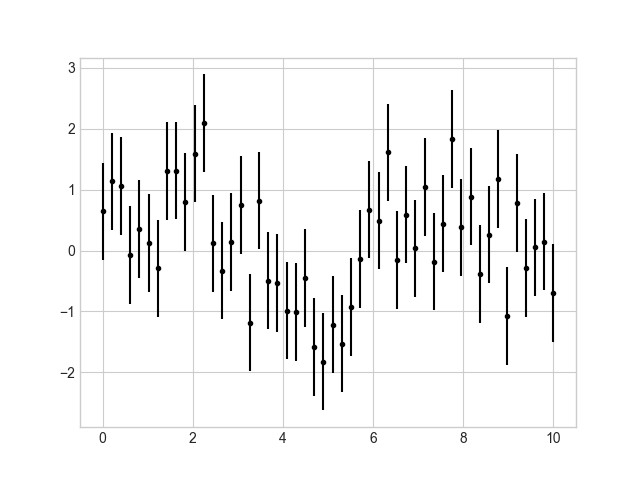
Matplotlib ievads
(1) Valoda un vide
(2) Datu punkti
(3) Joslas, histogrammas
(4) Anotēšana, eksplikācijas
(5) Aplīšu izmērs, krāsa
(6) 3D diagrammas
(7) MP4 video
from pylab import *
y = arange(0,3,0.1)
x = 2*y
hlines(y, 0, x, color='b', lw=4)
savefig('bars_hlines.png')
show()Pārrakstīts ar pilniem “vārdapgabaliem” (namespaces):
import numpy as np
import matplotlib.pyplot as plt
y = np.arange(0,3,0.1)
x = 2*y
plt.hlines(y, 0, x, color='b', lw=4)
plt.savefig('bars_hlines.png')
plt.show()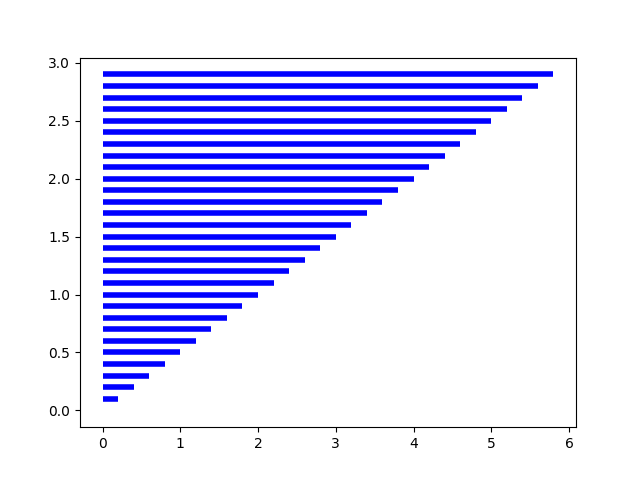
import matplotlib.pyplot as plt
import numpy as np
x = np.random.normal(2, 0.5, 100000)
plt.hist(x, bins=50)
plt.savefig('bars_histogram_plain.png')
plt.show()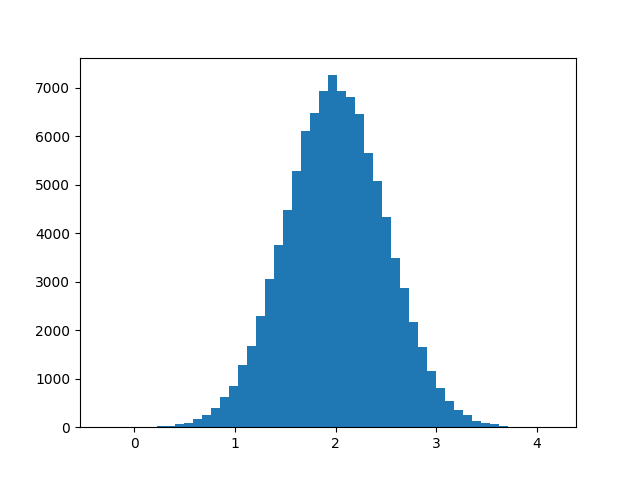
# -*- coding: utf-8 -*-
import numpy as np
import matplotlib.pyplot as plt
N = 10000
mu, sigma = 175, 7
x = mu + sigma * np.random.randn(N)
plt.hist(x, 50, density=True,
facecolor='g', alpha=0.75, ec='#000088')
plt.xlabel('Garums (cm)')
plt.ylabel('Varbūtība')
plt.title('%d cilvēku garums; μ=%d, σ=%d' %
(N,mu,sigma))
plt.text(60, .025, r'$\mu=%d,\ \sigma=%d$' %
(mu,sigma))
plt.axis([140, 210, 0, 0.07])
plt.grid(True)
plt.savefig('bars_histogram_separated.png')
plt.show()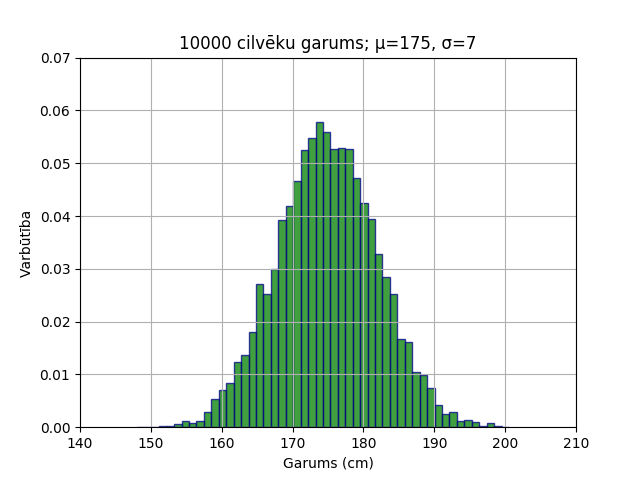
import numpy as np
#from pylab import *
import matplotlib.pyplot as plt
labels = ["Baseline", "System"]
data = [3.75, 4.75]
error = [0.3497, 0.3108]
xlocations = np.array(range(len(data)))+0.5
width = 0.5
plt.bar(xlocations, data, yerr=error,
width=width)
plt.yticks(range(0, 8))
plt.xticks(xlocations + width/2, labels)
plt.xlim(0, xlocations[-1]+width*2)
plt.title("Average Ratings")
plt.savefig('bars_with_errors.png')
plt.show()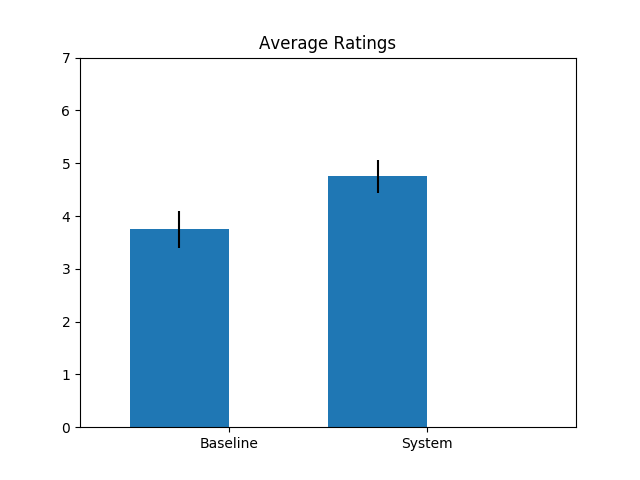
Matplotlib ievads
(1) Valoda un vide
(2) Datu punkti
(3) Joslas, histogrammas
(4) Anotēšana, eksplikācijas
(5) Aplīšu izmērs, krāsa
(6) 3D diagrammas
(7) MP4 video
from matplotlib.pyplot import figure, show, savefig
from matplotlib.patches import Ellipse
import numpy as np
fig = figure(1,figsize=(8,5))
ax = fig.add_subplot(111, autoscale_on=False, xlim=(-1,5), ylim=(-4,3))
t = np.arange(0.0, 5.0, 0.01)
s = np.cos(2*np.pi*t)
line, = ax.plot(t, s, lw=3, color='purple')
ax.annotate('arrowstyle', xy=(0, 1), xycoords='data',
xytext=(-50, 30), textcoords='offset points',
arrowprops=dict(arrowstyle="->")
)
ax.annotate('arc3', xy=(0.5, -1), xycoords='data',
xytext=(-30, -30), textcoords='offset points',
arrowprops=dict(arrowstyle="->",
connectionstyle="arc3,rad=.2")
)
ax.annotate('arc', xy=(1., 1), xycoords='data',
xytext=(-40, 30), textcoords='offset points',
arrowprops=dict(arrowstyle="->",
connectionstyle="arc,angleA=0,armA=30,rad=10"),
)
ax.annotate('arc', xy=(1.5, -1), xycoords='data',
xytext=(-40, -30), textcoords='offset points',
arrowprops=dict(arrowstyle="->",
connectionstyle="arc,angleA=0,armA=20,angleB=-90,armB=15,rad=7"),
)
ax.annotate('angle', xy=(2., 1), xycoords='data',
xytext=(-50, 30), textcoords='offset points',
arrowprops=dict(arrowstyle="->",
connectionstyle="angle,angleA=0,angleB=90,rad=10"),
)
ax.annotate('angle3', xy=(2.5, -1), xycoords='data',
xytext=(-50, -30), textcoords='offset points',
arrowprops=dict(arrowstyle="->",
connectionstyle="angle3,angleA=0,angleB=-90"),
)
ax.annotate('angle', xy=(3., 1), xycoords='data',
xytext=(-50, 30), textcoords='offset points',
bbox=dict(boxstyle="round", fc="0.8"),
arrowprops=dict(arrowstyle="->",
connectionstyle="angle,angleA=0,angleB=90,rad=10"),
)
ax.annotate('angle', xy=(3.5, -1), xycoords='data',
xytext=(-70, -60), textcoords='offset points',
size=20,
bbox=dict(boxstyle="round4,pad=.5", fc="0.8"),
arrowprops=dict(arrowstyle="->",
connectionstyle="angle,angleA=0,angleB=-90,rad=10"),
)
ax.annotate('angle', xy=(4., 1), xycoords='data',
xytext=(-50, 30), textcoords='offset points',
bbox=dict(boxstyle="round", fc="0.8"),
arrowprops=dict(arrowstyle="->",
shrinkA=0, shrinkB=10,
connectionstyle="angle,angleA=0,angleB=90,rad=10"),
)
ann = ax.annotate('', xy=(4., 1.), xycoords='data',
xytext=(4.5, -1), textcoords='data',
arrowprops=dict(arrowstyle="<->",
connectionstyle="bar",
ec="k",
shrinkA=5, shrinkB=5,
)
)
savefig('annotations_all.png')
show()
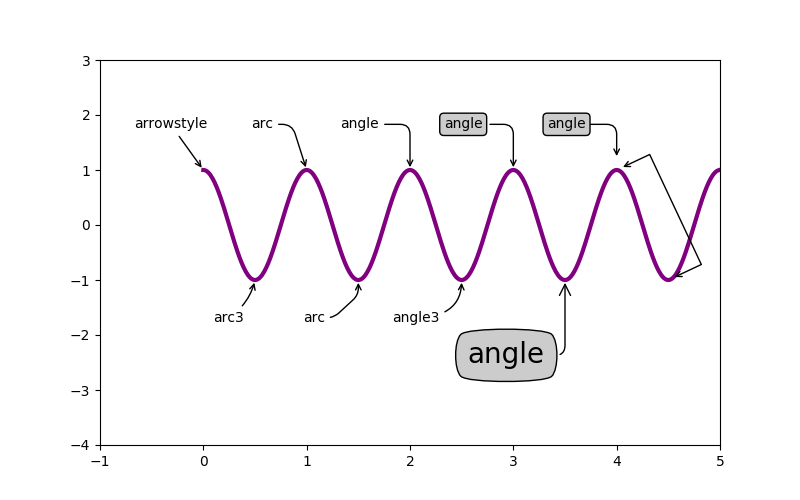
Matplotlib ievads
(1) Valoda un vide
(2) Datu punkti
(3) Joslas, histogrammas
(4) Anotēšana, eksplikācijas
(5) Aplīšu izmērs, krāsa
(6) 3D diagrammas
(7) MP4 video
from pylab import *
import numpy as np
x = np.random.random(50)
y = np.random.random(50)
c = np.random.random(50) # color of points
s = 500 * np.random.random(50) # size of points
fig, ax = subplots()
im = ax.scatter(x, y, c=c, s=s, cmap=cm.jet)
# Add a colorbar
fig.colorbar(im, ax=ax)
# set the color limits
im.set_clim(0.0, 1.0)
show()Matplotlib ievads
(1) Valoda un vide
(2) Datu punkti
(3) Joslas, histogrammas
(4) Anotēšana, eksplikācijas
(5) Aplīšu izmērs, krāsa
(6) 3D diagrammas
(7) MP4 video
import matplotlib as mpl
from mpl_toolkits.mplot3d import Axes3D
import numpy as np
import matplotlib.pyplot as plt
import matplotlib.image as mpimg
mpl.rcParams['legend.fontsize'] = 10
fig = plt.figure()
ax = fig.gca(projection='3d')
theta = np.linspace(-4*np.pi,4*np.pi,200)
z = np.linspace(-2, 2, 200)
r = z**2 + 1
x = r * np.sin(2*theta)
y = r * np.cos(2*theta)
ax.plot(x, y, z, label='parametric curve')
ax.legend()
plt.savefig('3d_parametric_curve.png')
plt.show()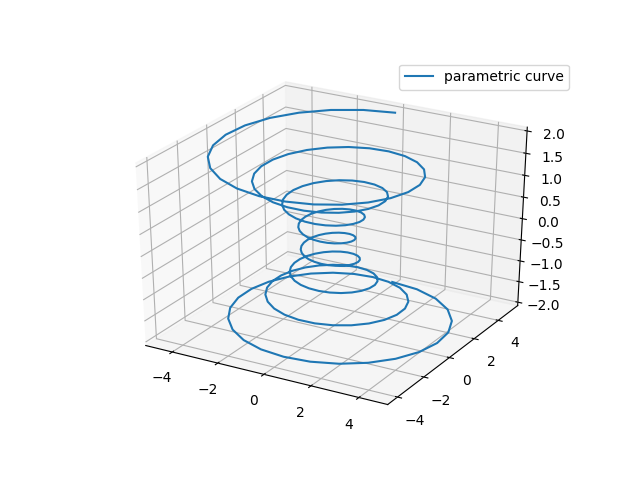
from numpy import *
import pylab as p
import mpl_toolkits.mplot3d.axes3d as p3
u=r_[0:2*pi:100j]
v=r_[0:pi:100j]
x=10*outer(cos(u),sin(v))
y=10*outer(sin(u),sin(v))
z=10*outer(ones(size(u)),cos(v))
fig=p.figure()
ax = p3.Axes3D(fig)
ax.plot_wireframe(x,y,z)
ax.set_xlabel('X')
ax.set_ylabel('Y')
ax.set_zlabel('Z')
p.savefig('3d_sphere.png')
p.show()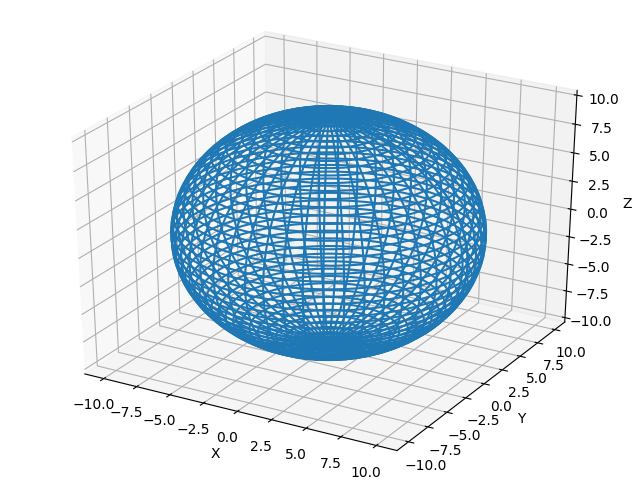
Matplotlib ievads
(1) Valoda un vide
(2) Datu punkti
(3) Joslas, histogrammas
(4) Anotēšana, eksplikācijas
(5) Aplīšu izmērs, krāsa
(6) 3D diagrammas
(7) MP4 video
# -*- noplot -*-
import numpy as np
import matplotlib
matplotlib.use("Agg")
import matplotlib.pyplot as plt
import matplotlib.animation as manimation
FFMpegWriter = manimation.writers['ffmpeg']
metadata = dict(title='Movie Test', artist='Matplotlib',
comment='Movie support!')
writer = FFMpegWriter(fps=15, metadata=metadata)
fig = plt.figure()
l, = plt.plot([], [], 'k-o')
print('type(l) = %s' % type(l))
plt.xlim(-5, 5)
plt.ylim(-5, 5)
x0, y0 = 0, 0
with writer.saving(fig, "writer_test.mp4", 100):
for i in range(100):
x0 += 0.1 * np.random.randn()
y0 += 0.1 * np.random.randn()
l.set_data(x0, y0)
writer.grab_frame()